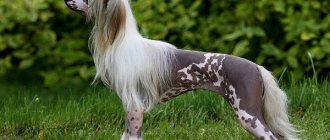Having noticed that your pet is bothered by itching, you need to make sure that he does not have fleas by carefully examining the animal’s fur and skin. The problem of itching and scratching is very common; you can read more about the pathology in our dictionary.
If the diagnosis confirms the absence of fleas, consider the other causes of itching listed in our article.
Main symptoms of allergy to pet dander
A pet allergy is an allergic reaction to proteins contained in the epidermal cells, saliva or urine of animals.
The main symptoms of a pet dander allergy are sneezing and runny nose. In some cases, this may manifest itself in difficulty breathing and an attack of bronchial asthma. Allergies can be caused not only by cats and dogs - the leaders in this matter, but also by parrots, guinea pigs, rabbits and hamsters. If you are interested in the question of whether you may be allergic to a certain cat, sign up for a consultation at our medical center. Risk factors:
- the presence of gastrointestinal diseases in a person;
- tendency to allergic reactions;
- hereditary predisposition;
- work related to animals.
Treatment of an allergy to cats in an adult is prescribed only after a thorough examination and medical history.
Treatment of food allergies in dogs
There is no cure for food allergies in dogs. There are no drugs or procedures that could help get rid of it. All that is possible is to eliminate individual symptoms (for example, itching, rash or diarrhea) with the help of different drugs.
Treatment for allergies in dogs consists of completely eliminating the offending foods from the diet . However, there is a difficulty here, and it lies in the fact that you first need to find the product that provokes the allergic reaction. To do this, the veterinarian prescribes an elimination diet.
Elimination diet
The main feature of this diet is not just replacing food, but creating a fundamentally new diet. The first thing you need to do is make a list of those foods that your dog has always eaten (for example, specific types of meat, vegetables and cereals), and then choose something fundamentally new for him. Typically, choose one source of protein and one source of carbohydrates.
For example, if your pet has never been given duck or rabbit meat, then this is perfect for his temporary (elimination) diet. Using the same principle, a product is selected that will be a complete source of carbohydrates. The main thing is that the dog has never eaten it before.
This task seems quite difficult, but do not worry - a veterinarian in Moscow will help in choosing a diet. It takes about 1.5-3 months to stick to the new menu. If after this time the skin itching or other symptoms have passed and have not returned, then this clearly indicates a food allergy.
Clinical manifestations of the disease
An allergic reaction can develop at any age, but children suffer from it much more often.
Respiratory system symptoms:
- difficulty breathing with whistling;
- dyspnea;
- chest pain, suffocation;
- cough, wheezing;
- nasal congestion, sneezing.
You can conduct an analysis to find out if you are allergic to cats in a special laboratory.
“Ocular” manifestations: redness of the eyes, swelling, increased lacrimation, itching, blurred image perception.
“Skin” symptoms:
- swelling;
- itching and peeling;
- redness of the skin;
- soreness.
Systemic disorders include: tachycardia, decreased blood pressure, nausea, pale skin, dizziness, loss of consciousness.
On our website Dobrobut.com you can make an appointment with a doctor who will tell you what to do if you have an allergy to cat hair. In addition, the clinic offers diagnostics, including special tests.
Caring for a dog with allergies
First of all, contact a veterinary clinic in Moscow. Follow all veterinarian recommendations, especially regarding nutrition. If possible, switch your dog to a hypoallergenic diet, having previously agreed with your veterinarian.
Take good care of your pet's skin and coat. Allergic reactions in 9 out of 10 cases are accompanied by skin itching and rashes, so stop using hard combs that injure the skin for a while.
Try to temporarily limit your pet’s contact with other animals (for example, while walking). Make sure your new diet contains enough vitamins and minerals necessary for your dog's health.
How does a cat allergy manifest in children?
Allergic manifestations to cats in most cases occur in children in the form of:
- difficulty breathing;
- "barking" cough;
- swelling and redness of the skin;
- watery eyes and redness of the eyes;
- nasal congestion.
If these symptoms occur, parents need to make an appointment with a pediatrician, who will prescribe a diagnosis and provide treatment.
Important: in most cases, the manifestation of signs of allergy to pets in infants is diagnosed in families in which one of the parents already suffers from some type of allergy.
The most common diseases of Chihuahua dogs
A predisposition to a disease does not mean that every Chihuahua will get it. Closely monitor your pet's condition and activity. If you see something wrong in your pet's behavior, it is best to contact a veterinarian.
The following diseases are not common in the breed, but they can occur:
- Knee dislocation . This is when the knee joint (often the back leg) slips inward, causing pain.
- Hypoglycemia . Low blood sugar is a possible problem for all toy breed puppies. Hypoglycemia is easily treated in its early stages, but can be fatal if left untreated.
- Heart murmurs . Caused by impaired blood flow through the chambers of the heart. They are an indicator that there may be a heart-related condition that needs to be monitored and treated.
- Pulmonary stenosis . This congenital heart disease occurs when blood does not flow properly through the heart because the pulmonary valve is abnormally shaped, causing an obstruction. Treatment depends on the severity of the disease. In mild cases there are few or no obstructions and no treatment is required. If the disease seriously affects the dog, surgery is recommended.
- Collapsed trachea . It is not entirely clear how this happens, but inhaling air quickly makes it difficult for air to enter the lungs.
- Hydrocephalus . Cerebrospinal fluid can accumulate in the brain due to a birth defect or injury during childbirth, which puts pressure on the brain. The head appears swollen or enlarged, but the diagnosis can be confirmed by ultrasound if necessary. Puppies with severe cases usually die before four months of age.
- Open Fontanel . Chihuahuas are born with a soft spot on the top of their head. Usually the soft spot closes, very similar to the child's will, but sometimes it does not close completely. Treat these dogs with care. An accidental blow to the head can kill them.
- Trembling . A common occurrence in Chihuahuas. The mechanics of why they shiver or tremble are unclear, but it usually occurs when the dog is excited, tense, or cold.
Manifestation of signs of allergy to pets in infants
Due to immature immunity, an allergy to animals in infants manifests itself immediately after contact with the allergen. The main symptoms of this type of allergy include: swelling of the subcutaneous tissue, redness of the skin, itching, nasal congestion or increased nasal discharge, sneezing, dry cough, conjunctivitis. In addition, the baby may experience general malaise, fever, and diarrhea. If such symptoms are detected, parents should urgently seek medical help, since this condition is very dangerous for the baby.
Quantitative determination in the blood of specific immunoglobulins of class E to the recombinant allergic component of the dog rCan f 2.
Synonyms Russian
Specific immunoglobulin class E to the recombinant allergic component of the dog.
English synonyms
rCan f 2 Dog (Canis familiaris).
Research method
Solid phase immunofluorescence (ImmunoCAP).
Units
kUA/l (kilounit of allergen per liter).
What biomaterial can be used for research?
Venous, capillary blood.
How to properly prepare for research?
- Do not smoke for 30 minutes before the test.
General information about the study
An allergen is a substance that causes an allergic reaction. There are a huge number of substances of natural or artificial origin, each of which can become an allergen for humans.
The main participant in an immediate allergic reaction (type 1) is immunoglobulin E (IgE). For each allergen there is a specific immunoglobulin E. The purpose of this test is to determine the allergic reaction to the dog's allergen.
There is a misconception that allergies are caused by animal fur, but this is not true. The main activity in the formation of an allergic reaction is shown by secretions (saliva, urine, etc.) and animal dander. Only after contact with the animal’s skin do the allergens reach the fur.
This allergen belongs to the group of epidermal ones. In addition, this group also includes wool, fluff, feathers, excrement and saliva of various animals. They enter the body by air, through contact with animals.
Dog allergens are ubiquitous. They are found even in rooms where there are no pets - in educational institutions, shopping centers, public transport, with high concentrations in dust, in mattresses, furniture, and textiles.
The main epithelial allergens of dogs can be found in fur, dander, saliva and serum. Allergen concentrations vary between and within different dog breeds. Although allergen molecules differ depending on their source (saliva or epidermis), there are no breed-specific allergens. To date, 28 dog allergens have been isolated from various biological substrates. Allergen Can f 2 is a lipocalin, a 19 kDa protein found in dog dander and saliva; formerly known as Can d 2. One of the lipocalin family, homologous to mouse urine protein. Most studies indicate that it is not a very significant allergen—it was found to react with IgE antibodies in 66% of dog allergy patients. The recombinant allergen can be used in allergy diagnostics to identify individuals sensitive to Can f 2, but alone is not an indicator of dog allergy.
Allergy symptoms can appear within 3-5 minutes after contact with the allergen; as a rule, they increase over time and reach a maximum after 3-4 hours. Immediate and delayed hypersensitivity reactions occur in sensitized individuals in the form of clinical manifestations such as allergic conjunctivitis, allergic rhinitis, rhinoconjunctival syndrome, and on the skin in the form of urticaria, eczema, itching. In sensitized individuals with bronchial asthma, as a rule, inhalation of allergens after 20-30 minutes can cause cough, shortness of breath, bronchospasm, sometimes the hypersensitivity reaction occurs in a delayed manner - a decrease in bronchial patency begins in patients after 3-4 hours.
Quantitative determination of specific IgE antibodies allows us to assess the relationship between antibody levels and clinical manifestations of allergy. Low values of this indicator indicate a low probability of allergic disease, while a high level has a high correlation with the clinical manifestations of the disease. By detecting high levels of specific IgE, it is possible to predict the development of allergies in the future and a more pronounced manifestation of its symptoms. However, the concentration of IgE in the blood is unstable. It changes with the development of the disease, with the amount of allergen dose received, as well as during treatment. It is recommended to repeat the study if symptoms change and treatment is monitored. You should consult your doctor about the need for re-examination.
ImmunoCAP is characterized by high accuracy and specificity: even very low concentrations of IgE antibodies are detected in a small amount of blood. The study is revolutionary and is based on the immunofluorescent method, which allows it to increase sensitivity several times compared to other tests. The World Health Organization and the World Allergy Organization recognize the ImmunoCAP diagnosis as the “gold standard”, as it has proven its accuracy and consistency in independent studies. Thus, identifying specific IgE using this technique takes allergy diagnostics to a qualitatively new level.
What is the research used for?
- Detection of sensitization to the dog allergen rCan f 2 in children and adults;
- determination of possible causes of allergic diseases (allergic rhinitis/rinoconjunctivitis, bronchial asthma, atopic dermatitis, angioedema, urticaria);
- control of ongoing drug treatment and allergen-specific immunotherapy (ASIT).
When is the study scheduled?
- For symptoms indicating an allergic nature after possible contact with a dog allergen: redness and burning of the mucous membrane of the eyes, lacrimation and swelling of the eyelids, nasal congestion, sneezing, coughing, shortness of breath, bronchospasm;
- when assessing ongoing drug treatment and allergen-specific immunotherapy (ASIT);
- when examining children and adults with bronchial asthma, allergic rhinitis/conjunctivitis, atopic dermatitis, urticaria, angioedema, anaphylactic shock and other manifestations of allergic diseases.
What do the results mean?
Reference values: 0 - 0.35 kU/l.
Reasons for increased levels of specific IgE:
- presence of sensitization to the dog allergen rCan f 2.
Reasons for decreased levels of specific IgE
With repeated research (over time), the level of specific IgE may decrease for the following reasons:
- limiting or eliminating contact with the allergen;
- carrying out drug treatment.
Diagnostics
After a thorough examination of the patient and collection of anamnesis, the doctor in most cases will prescribe additional research methods, namely: blood test, urine test, blood biochemistry, immunogram and special skin tests.
How is a skin test performed? A small amount of purified extracts of various allergens is applied to the skin in the forearm area. At the site where the solution is applied, a puncture is made with a needle or an incision with a scarifier. The test results are assessed after 15 minutes. The most common side effects of the test include itching and redness of the skin, which go away on their own within an hour.
We will talk further about how to determine if a child is allergic to a dog and what parents should do as first aid.
Most common symptoms
Let's discuss the most common clinical signs (symptoms) of food allergies in dogs.
As a rule, these are young dogs (up to a year old) or middle-aged and older dogs (6 years and older). Even predisposed breeds have been identified: German Shepherds, West Highland White Terriers, Boxers, Rhodesian Ridgebacks, Pugs. How do food allergies manifest in dogs? The disease can have both skin lesions and disorders of the gastrointestinal tract (chronic vomiting and diarrhea). The main and most noticeable acute skin symptoms of food allergies in dogs are presented in the photo.
At the beginning, they include itching and self-injury (scratching), then bacteria settle on the inflamed and injured skin, which can cause more serious problems, for example, purulent inflammation of varying severity (from superficial “pimples” to deep boils), and of course inflammation of the ears (otitis media). By the way, otitis media, including those that have been occurring for a long time, can be a symptom of a food allergy, even if the dog otherwise feels well.
Rice. 1 and 2. Acute and chronic food allergies in dogs
If the disease develops for a long time, then you can observe thickening of the skin, especially in the armpits, groin and under the tail, inflammation of the skin between the fingers, severe purulent inflammation of the skin and ears, and weight loss. You can see what the symptoms of chronic food allergies look like in the photo.
Fig 3,4,5. Manifestations of food allergies in dogs: Malassezia dermatitis, microbial otitis media, bacterial folliculitis.
Treatment
Doctors use the following medications to treat allergic conditions:
- antihistamines;
- enterosorbents;
- corticosteroids;
- decongestants.
Antihistamines: Tavegil, Claritin, Diphenhydramine.
Corticosteroids are especially effective for allergic symptoms, however, they are not safe. The drugs have a number of side effects and can only be prescribed by a specialist who will tell you how allergies to cats manifest in children and how to help your child at home.
Origin of the breed
The breed was very popular among the European aristocracy in the late 19th and early 20th centuries. Miniature English Toy Terriers were bred in Great Britain by crossing dogs of decorative and hunting breeds.
Manchester terriers, small English greyhounds and Italian greyhounds left their mark on the pedigree of toy terriers. Initially bred for hunting small burrowing animals, the breed soon began to be considered decorative, “sofa”. It was customary to have such dogs in noble houses, carry them with you, and take them on trips. From Europe, the “travelers” reached Russia, where difficult times awaited the breed at the beginning of the last century.
The October Revolution changed the mentality of the people. And everything that was previously considered aristocratic, “lordly” was stigmatized and quickly forgotten. Dogs with a characteristic noble reputation did not fit into the new ideology of society. From the 20s to the 50s, no breeding work was carried out with the breed at all. The situation changed only in 1956, when Soviet cynologists announced the start of work on breeding “our” Russian Toy Terrier breed.
Already in the late 50s, the first smooth-haired representatives of the breed were bred, very similar in appearance and character to their British counterparts. They called them Russian Toy Terriers. Just two years later, breeders introduced long-haired dogs called Moscow Toy Terriers. Since then, breeding work has not stopped.
from the personal archive / Olga Moskaleva
In the mid-90s, the first national breed club appeared in Moscow, and a year later the first exhibition was held. But the results of the work of Soviet breeders were not recognized internationally for a long time. The standards recognized by the Fédération Cynologique Internationale turned out to be different from the description of the Toy Terrier breed bred by Soviet breeders. It was only in 2006 that the breed received conditional recognition from the international community. But it was renamed: the word terrier disappeared from the name, since experts agreed that these dogs had nothing in common with terriers. And Russian and Moscow Toy terriers were combined into one standard - Russian Toy, which applies to smooth-haired and long-haired representatives.
Russian Toys received final recognition in 2022, and today breeders have the right to represent their pets at the Fédération Cynologique Internationale championships.
Prevention
Of course, the best solution would be complete isolation from the allergen. But if you are not ready to part with your pet, the following measures will help minimize contact with the irritant protein:
- daily wet cleaning;
- daily ventilation of the room, especially before bedtime;
- washing hands after contact with animals;
- using an air purifier;
- Do not allow animals into the room of an allergic person.
If you have any questions, please make an appointment. During a personal conversation, the doctor will answer them and tell you whether cats do not cause allergies. Registration takes place by phone and online.
Related services: Pediatric allergology
The connection between allergies and otitis media
Allergens that enter the dog's body are recognized by it as infectious agents, and then lymphocytes are sent to fight them. To make it easier for lymphocytes to get to the site of allergen penetration, immune cells release histamine into the blood, which improves vascular permeability.
As a result of increased vascular permeability, lymphocytes leak into the tissues, forming infiltrates - nodules and plaques, and an inflammatory process begins in the dog's ear. Most often, otitis media affects both ears at once, but sometimes inflammation occurs in only one.
In addition, the microflora in the ears is disrupted; the dog scratches them and pathogenic microflora easily penetrates there - bacteria, fungi, yeast, i.e. secondary infection occurs.
Puppy in the house - care and education
“Dogs do not require special living conditions,” notes breeder Olga Moskaleva. — You need to vaccinate your toy terrier on time, feed him dry food and worm him no more than once every six months and 2 weeks before vaccination. Despite their apparent fragility and miniature size, they have excellent health.”
The expert advises interfering as little as possible with your pet’s health. He does not need to be bathed regularly. Moreover, this should only be done if absolutely necessary. When bathing with shampoo, the protective barrier is washed away from the surface of the skin. This leads to dry skin and dandruff, as well as a “dog” odor, which is not typical for small breed dogs. Usually the one smells like the house in which he lives, or the bed, if the owners let him into the bed. And it begins to smell like “dog” due to frequent bathing, in response to which the animal’s skin begins to actively produce a secretion with a specific odor.
Olga Moskaleva also does not recommend cleaning a dog’s ears and eyes, as it only depresses the animal’s immunity and leads to inflammation. And among the mandatory grooming procedures, he only lists nail trimming once every two weeks. Due to the light weight of the animal, the claws do not have time to grind down on the asphalt when walking.
In the house, the puppy needs to immediately set boundaries and make it clear what he can do and what he cannot do. You shouldn’t wait for your baby to grow up and allow him to do things today that you wouldn’t want to see in the behavior of an adult dog tomorrow. Nowadays, small pranks, for example, a baby walking across the dining table or sleeping on the owner’s pillow, can cause affection. But in the future, your attitude towards your pet's behavior will most likely change.
“The dog does not understand that it has grown,” comments Olga Moskaleva, “it is just gaining experience. Therefore, it is very important to raise a puppy from the first seconds of being in the house. If you don't want your dog to lie on the sofa while you're away, never take it to the sofa. Immediately stop everything that you think your pet should not do.”
from the personal archive / Olga Moskaleva











